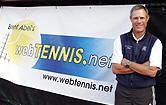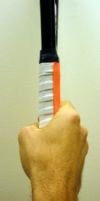|

Custom Search
An effective tennis serve is crucial to your development as a player. The ability to incorporate different types of tennis service to your game is vital in winning matches. The serve is a complicated stroke, composed of a series of motions, the objective of which is hitting the ball in a timely manner to be effective. How you hold the racket, how you position your feet, how you throw the ball, how you position your body prior to the impact of the tennis racquet hitting the ball are all important aspects of the stroke. And also keep in mind that the rhythm of your service directly affects your timing and the effectiveness of your serve.
There are three basic types of service: the flat or basic serve, the topspin , and the slice. It is important to choose the tennis serve depending on your physique and the requirements of the match that you play at any particular time. Usually, the flat tennis serve is used for the first serve, the topspin for the second serve and the slice as a variation tennis serve. Here are the primary components of the serve prior to the actual moment the racquet hits the ball: Service Stance Remember to modify your stance according to each type of tennis service. However, generally speaking, your feet should be shoulder-width apart, your front foot a few inches away from the baseline to avoid foot fault, two feet away from the centermark, your knees bent. The Grip The ideal grip for serving is the Continetal grip. This grip allows you maximum snap in your wrist for power and at the same time, imparts spin when you hit the ball.
Holding The Ball Hold the ball between your thumb and all four fingers. Position of Your Feet Align your feet so that your toes point toward the target area. Allow for some variation according to the type of serve. The Ball Toss The ball should be tossed in front, slightly to the right of the leading shoulder, and at least a little higher than you could reach with your racquet so that the ball is hit after it has fallen a few inches. Coordinate your movement so that the you release the ball when your tossing arm is at full stretch. There is a slight variation in the ball toss according to the type of the tennis serve.
Types of Serves 3. Slice Serve
Tips & Advice Remember, you're only as good a player as your second serve. Your first tennis serve might be as fast as Andy Roddick's when it hits the court 15% of the time, and you consistently dink the second one, then it's fair to say that you won't win many matches. You've got to develop a dependable second tennis serve. Slow down your second serve using ball control (spin), and body control (at point of contact on the serve, the left leg and the right arm - or the right leg and the left arm if you're left-handed, should be in a straight line). On the ball toss, concentrate on the wrist because it causes the ball to go wherever it goes - long, short, left or right.
Improving Your Stroke The more fluid your tennis serve motion, the more effective your serve becomes. I know it's not easy for a beginner but constant practice will take care of that. As you prepare to swing at the ball, take the racquet back and lift it into a throwing position between your shoulder blades as you toss the ball. Remember that serving the ball is basically like throwing the ball with your hand except that you use the racquet to do it. Keep your racquet high and away from your body. This motion is the trigger for the hitting thrust at the ball. The farther the racquet is away from the ball, the more momentum it gathers the moment it hits the ball with legs, shoulders, hitting arm and wrist all playing their parts in that fluid motion. Below are a general series of steps needed to accomplish a well-hit tennis serve. They basically apply to all kinds of serves. 1. As you take the racquet back, the inside of your hitting wrist and the hitting face of your racquet should point towards the court surface at the end of the take-back. 2. Push your front hip forwards as you move your weight over your bent front knee, thereby stabilizing your front foot. 3. The back shoulder must turn in to add its power to the hit as the racquet head is thrown up to meet the ball. It is very important to time the shoulder turn. Turning the hitting shoulder too early or too late will result in an ineffective tennis serve. 4. Keep your head up with your eyes on the ball at all times. At the hit the wrist should snap forwards to present the strings to the back of the ball, with an up, through and over action. Be careful not to baby this shot, so to speak. Hit the ball with authority. 5. During the follow through, let the racquet go past your left leg (or right leg, if you're left-handed) as your momentum carries you forward onto your right foot which has swung through across the baseline.

Brent Abel is highly recommended to: • Dramatically improve your tennis strokes... - tennis serve - one-handed backhand groundstroke - forehand groundstroke - two-handed backhand groundstroke - forehand and backhand volleys - returns of serve for singles & doubles - overhead - lob - drop shot • Understand the simple yet essential keys to footwork. • Develop the necessary mental skills for practice and competition • Be more focused on court positioning - Finally understand exactly how superior court positioning in your singles and doubles strategies can have an enormous effect on challenging your opponents. • Get fitter and learn simple exercises for tennis specific injury prevention, greatly reduce the risk of tennis elbow, rotator cuff, and other tennis related injuries • Learn to become an "all-court" tennis player instead of just being a one-dimensional predominantly baseline player • Enjoy this beautiful game throughout your lifetime. Go to his site, WebTennis.net.

Custom Search
|
